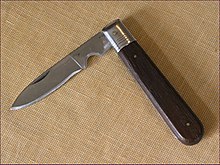Penknife, or pen knife, is a small folding knife.[1] Today penknife is also the common British English term for both a pocketknife, which can have single or multiple blades, and for multi-tools, with additional tools incorporated into the design.[2]



History edit
Originally, penknives were used for thinning and pointing quills (cf. penna, Latin for feather) to prepare them for use as dip pens and, later, for repairing or re-pointing the nib.[1] A penknife might also be used to sharpen a pencil,[3] prior to the invention of the pencil sharpener. In the mid-1800s, penknives were necessary to slice the uncut edges of newspapers and books.[4]
A penknife did not necessarily have a folding blade, but might resemble a scalpel or chisel by having a short, fixed blade at the end of a long handle.[citation needed]
During the 20th century there has been a proliferation of multi-function pocketknives with assorted blades and gadgets,[5] the most famous of which is the Swiss Army knife, referred to in British English as penknives.
A larger folding knife than a penknife, especially one in which the blade locks into place as a protection, as for skinning animals, is referred to by some as a claspknife.[5]
See also edit
References edit
- ^ a b A Society of Gentlemen in Scotland (1773). Volume 3. Oxford University: John Donaldson 195 The Strand. p. 524. Retrieved 18 December 2014.
upon your knee with the back of a penknife,
- ^ Moore, Simon (1988). Penknives and Other Folding Knives. Osprey Publishing. pp. 25–26. ISBN 978-0-85263-966-5.
- ^ Arthur Machen (1895). The Three Impostors. London: John Lane.
As he came along in the train, he had been sharpening a pencil, and the sudden jolt of the engine as it drew up at a station had driven the penknife against his face...
- ^ Flanders, Judith (2014). The Victorian City: Everyday Life in Dickens' London. New York, NY: St. Martin's Press. p. 152. ISBN 978-1-250-04021-3.
- ^ a b Shackleford, Steve (5 January 2010). Blade's Guide to Knives & Their Values. Iola, Wisconsin: Krause Publications. pp. 219–222. ISBN 978-1-4402-1505-6.